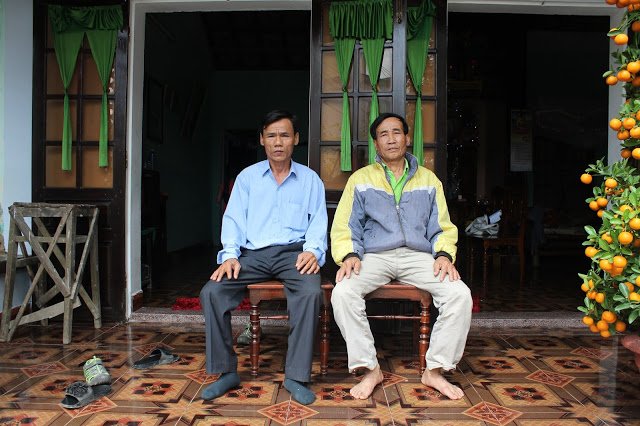Precursor to the Mỹ Lai Massacre: 1968 Phong Nhị, Phong Nhất_10(4)
My meeting with Trần Diệp (right) and Trần Văn Hiệp in February of 2018. Trần Văn Hiệp is the baby that was born, right around the time of the massacre on February 12, 1968. Photograph by humank
Chapter 10(4) : Trần Diệp’s search for his brother Trần Thử’s corpse covered in banana leaves
“Oh dear, poor thing.”
Trần Diệp’s wife, Hà Thị Nữ(1959~), who was cleaning next to him, muttered under her breath, listening to her husband retell the story of how he lifted up pieces of banana leaves in search of his younger brother. She kept wiping the corners of her eyes. When he got to the part about how he was shot and therefore limping aimlessly in the open space before he finally found his brother, his aunt, Trần Thị Ớt, began crying as well. Only Trần Diệp, who actually experienced all this, seemed composed. He rolled up his pants to show us the gunshot wound on his outer right shin. .
Trần Diệp, whom I met for the first time in January 2013, owned a small shop in front of his home in Phong Nhất. It was a general shop selling all sorts of things from children’s toys to rice and snacks. That day, his aunt, who happened to live nearby, stopped by for a visit. She was the one who had been with Trần Diệp’s mother, who was undergoing postnatal care at the hospital in Dien Banh, when they heard the news. His aunt had thereafter returned to the village and witnessed the horrendous scene of the massacre.
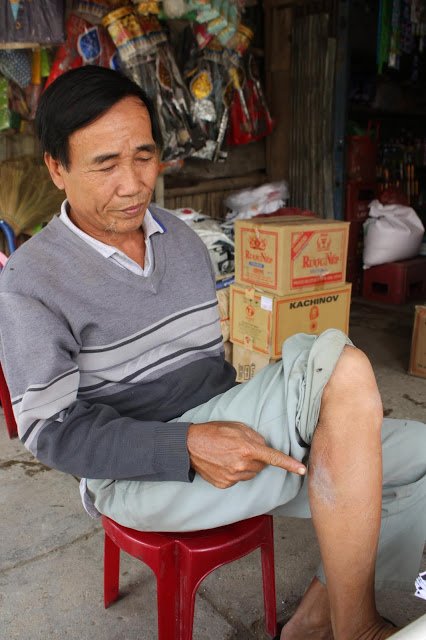
Trần Diệp, in January of 2013. Rolled up his pants to show me the wound on his right shin. Photograph by humank
Whenever Trần Diệp seemed to have trouble articulating, his aunt would supplement his recollection. “Even seeing just one or two dead bodies is frightening, but we saw so many corpses that day that in fact, we weren’t even scared” (Trần Diệp). “It was truly gruesome, I tell you. The most ghastly of sights were dead children’s bodies. I saw a baby who was eight months old at best, stabbed all over his body. I also saw corpses that were completely burned up. It was Trần Lọ and Võ Thị Canh--the couple with no children. They were both short to begin with, but they had shrunk by half their size in the fire. My nephew, in comparison, didn’t have it as bad” (Trần Thị Ớt).
Trần Diệp suddenly raised his voice a bit, as if he remembered something from that day. “I want to pose this question to the Korean people. Shooting guns during war is a matter of course, but why did you collectively aim those guns at powerless civilians? Why did they stab the corpses with knives, even after killing? Why did they shred children’s corpses and throw them into the well and creek? What harm could women and children possibly inflict that they would do such a thing? Trần Thị Ớt chimed in, saying, “The Korean soldiers would feel differently, if the people who were killed were their own families. Only the passing of time made it possible for us to even face you Koreans again, otherwise, this encounter wouldn’t have even taken place.”
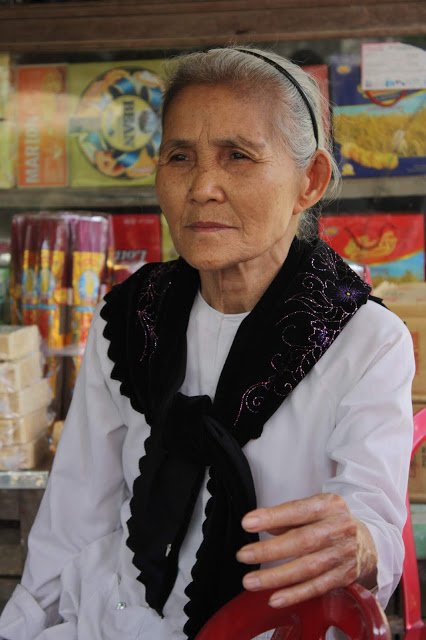
Trần Diệp’s aunt, Trần Thị Ớt, who directly witnessed the corpses after the massacre (Photo taken in January 2013). Photograph by humank
Trần Diệp, who witnessed the corpse of his younger brother on the day of the massacre, lost his mother, Nguyễn Thị Xuyên, who had stepped on a landmine. After the incident, he left the village and lived with his uncle in Bình Điền. However, that meant running into Korean soldiers more often, as it was an area where the Korean troops frequently ran reconnaissance. “I had to see them almost every day. I remember the letters “Kim” written on their uniforms. They would call each other ‘Kim something-something’.“
Five years later in 1973, his father also passed away from stepping on a landmine. Trần Diệp was 18 years old then. It was time for him to enter the South Vietnamese army, but he lied that he was born in 1958, making him 5 years younger than his actual age, in order to avoid being drafted. Supposedly, there was someone in the army that turned a blind eye to this. He worked as an electrician until Vietnam was united in 1975 and he was able to make to back down to Phong Nhất.
Phong Nhị and Phong Nhất in 1975 was a vast wilderness. They say from when the villages were ravaged on February 12, 1968, there wasn’t a single house left. The villagers slowly returned to their hometowns one by one and started rebuilding homes. Trần Diệp had to take care of his younger siblings who, like him, were orphans, as well as his grandparents. He built a thatched-roof house with the help of his neighbors. He got married in 1976 and in 1979, received a land grant of 3300 square meters from the country. It was 4000 square meters including the land for building his home. Land was distributed proportionally to the population. Since it was him, his wife, two children, and four siblings (8 people in total), it came out to 500 square meters per person.
I visited Trần Diệp again in February of 2018. He told me he relocated his store, as before, it was a leased space, but now he bought land to build a new brick building. His youngest sibling Trần Văn Hiệp happened to be there when I visited him. Trần Văn Hiệp was the baby that his mother gave birth to in Dien Banh, around the time of the massacre on February 12, 1968. He didn’t say a word next to his brother. He seemed uncomfortable in meeting someone who had come from Korea. Luckily, he willingly participated in taking a few photographs.
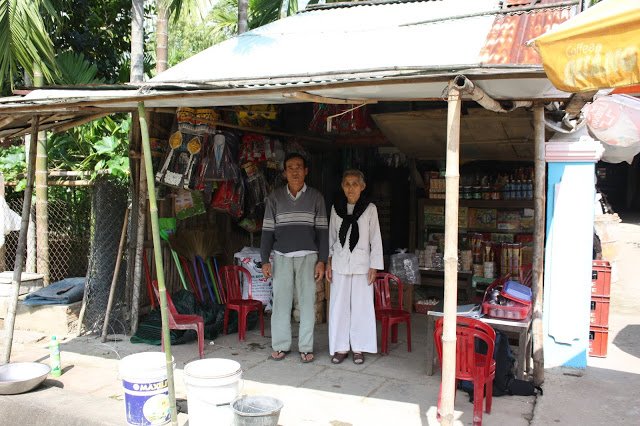
Trần Diệp with his aunt, Trần Thị Ớt (Photo taken in January 2013). Photograph by humank
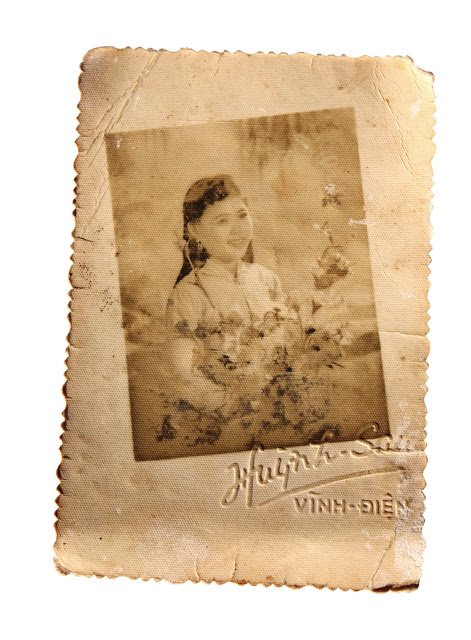
Trần Thị Ớt, in her younger days.
Trần Diệp brought up his aunt, Trần Thị Ớt, who participated in the interview five years ago in 2013. She was hospitalized in Dien Banh because of a chronic disease. I asked if it would be possible to visit her, but he shook his head, saying her condition was grave. I recall that even five years ago in 2013, she didn’t have a typical 70-year old’s face. “She must’ve broken several hearts when she was younger, “ I said during the interview at the time, when another villager who was spectating the interview chimed in to say, “You have a good eye for beauty! Thị Ớt used to be the most beautiful girl, not only in the villages, but also in the neighboring areas. But she married the most unsightly man in our neighborhood! What a tragic turn of events.” Trần Diệp and Hà Thị Nữ, whose faces were once dark and solemn, lit up with laughter. Trần Thị Ớt threw up after seeing the corpses on February 12, 1968 and couldn’t eat anything for an entire week. That same woman was now hospitalized, half unconscious, unable to eat or speak.
Trần Diệp looked at me intently as he said, “The past is the past; we must live in the present.”
- Written by humank (Journalist; Seoul, Korea)
- Translated and revised as necessary by April Kim (Tokyo, Japan)
The numbers in parentheses indicate the respective ages of the people at the time in 1968.
This series will be uploaded on Steemit biweekly on Monday.
